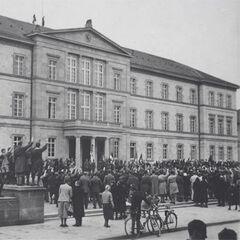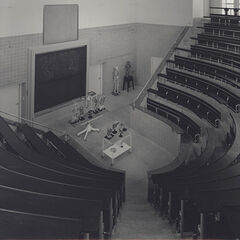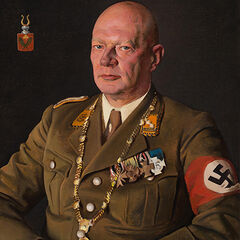Neue Aula: Tübingen University during National Socialism
Station im Stadtrundgang: History Path to National Socialism
Since its construction in 1845, the Neue Aula (New Auditorium) has been the university's central building. During National Socialism, members of Tübingen University tried to provide the ideology of the new rulers with scientific underpinnings and were involved in National Socialist crimes.
From the late 19th century to 1945, the Eberhard Karls Universität was characterized by an anti-Semitic atmosphere. In 1935, biologist Ernst Lehmann wrote in retrospective: "Tübingen was always able, without using a lot of words, to keep away Jewish professors." During the Weimar Republic, there was only one Jewish professor who held a chair; he left Tübingen in 1931.
In 1933, numerous professors and lecturers showed their loyalty to the new National Socialist government. Students raised the swastika flag on the Neue Aula. Within a short span of time, many teachers and students joined various party organizations of the Nationalsozialistische Deutsche Arbeiterpartei (National Socialist German Workers' Party, NSDAP). Members of the university willingly pressed ahead with their school's "Gleichschaltung" (forced coordination).
Numerous scientists from the university were involved in preparing reports for forced sterilizations or for racial classifications. In 1934, the Rassenkundliches Institut (Institute for Racial Studies) was founded. Protestant theologians Gerhard Kittel (1888-1948) and Karl Georg Kuhn (1906-1976) developed an anti-Semitic "Judenforschung" (Jewish Studies). During World War II, it was especially the university's clinics that deployed forced laborers.
There was nearly no resistance against National Socialism at the university. After 1945, almost half of the teaching staff was dismissed on charges of being politically compromised. Within a decade, though, the university had re-employed 85 per cent of them.
Image 1
Raising of the swastika flag on the Neue Aula (New Auditorium) by members of the Nationalsozialistischer Deutscher Studentenbund (National Socialist German Student League, NSDStB) on March 9, 1933. Some of them would later become high-ranking members of the Geheime Staatspolizei (Secret State Police, Gestapo) and the Schutzstaffel ("Security Squadron", SS) and were majorly involved in deportations and mass shootings of Jews in German-occupied eastern and southeastern Europe. Photo: University Archives Tübingen
Image 2
Medical students dissected the bodies of over 500 victims of National Socialist rule in the Anatomisches Institut (Anatomical Institute) on the Österberg hill (undated photograph). The remains were afterwards buried in the Gräberfeld X (burial plot X) on the Tübingen Stadtfriedhof (city cemetery). Individual anatomical specimens were finally removed from the university's collections as late as 1989. Photo: University Archives Tübingen
Image 3
Psychiatrist Heinrich F. Hoffmann (1891-1944), Rektor (President) of Tübingen University from 1937 to 1938, had his portrait, painted for the Professorengalerie (Gallery of University Professors), depict him in his brown-shirt stormtrooper Sturmabteilung ("Storm Detachment", SA) uniform. As director of the Universitätsnervenklinik (University Psychiatric Hospital) from 1936 to 1944, he filed numerous applications for forced sterilizations. Photo: Museum of the University of Tübingen MUT / Valentin Marquardt




